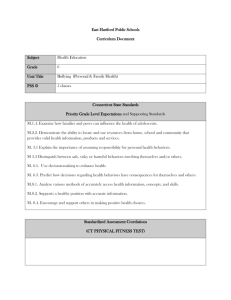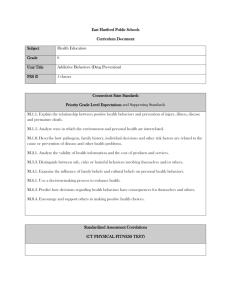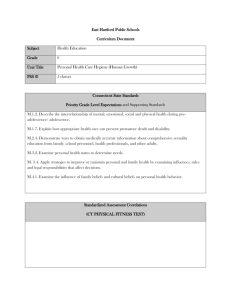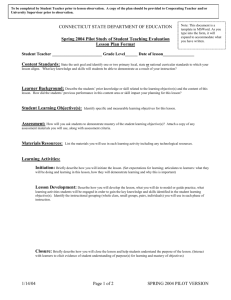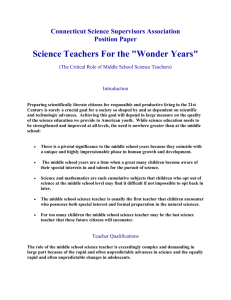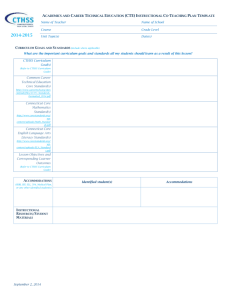East Hartford Public Schools Curriculum Document Subject Health
advertisement
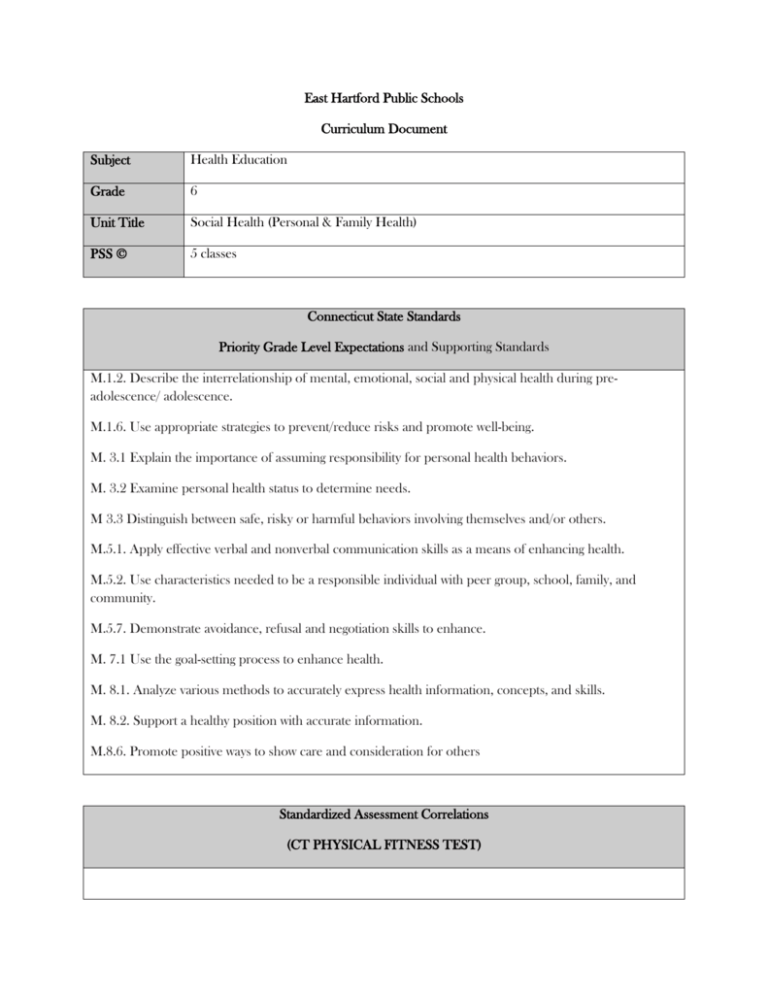
East Hartford Public Schools Curriculum Document Subject Health Education Grade 6 Unit Title Social Health (Personal & Family Health) PSS © 5 classes Connecticut State Standards Priority Grade Level Expectations and Supporting Standards M.1.2. Describe the interrelationship of mental, emotional, social and physical health during preadolescence/ adolescence. M.1.6. Use appropriate strategies to prevent/reduce risks and promote well-being. M. 3.1 Explain the importance of assuming responsibility for personal health behaviors. M. 3.2 Examine personal health status to determine needs. M 3.3 Distinguish between safe, risky or harmful behaviors involving themselves and/or others. M.5.1. Apply effective verbal and nonverbal communication skills as a means of enhancing health. M.5.2. Use characteristics needed to be a responsible individual with peer group, school, family, and community. M.5.7. Demonstrate avoidance, refusal and negotiation skills to enhance. M. 7.1 Use the goal-setting process to enhance health. M. 8.1. Analyze various methods to accurately express health information, concepts, and skills. M. 8.2. Support a healthy position with accurate information. M.8.6. Promote positive ways to show care and consideration for others Standardized Assessment Correlations (CT PHYSICAL FITNESS TEST) Subject Health Education Grade 6 Unit Title Social Health (Personal & Family Health) PSS © 5 classes Big Ideas Essential Questions 1. Social health can have a profound impact one’s overall wellness. How can communication enhance my personal health and develop positive relationships? 2. How do I build and maintain a healthy relationship? Concepts Skills (what students need to know) (what students need to be able to do) How to build and maintain healthy friendships. Demonstrate communication among individuals. Skills for effective speaking. Encourage others to make healthful choices. Effective listening skills. Characteristics of non-verbal communication. Demonstrate message tactics and strategies. (i.e. respectful tone, role play, written scenario) Demonstrate refusal skills. (i.e. walk away, role play, written scenario) Bloom’s Level 1-2 1-2 3 3 Assessments Pre-Assessment “Dipsticks” (Informal Progress Monitoring) As determined by: True/False Unit Content Open-ended response Symbols/charts prior knowledge Collins Writing Types 1-5 Projects & presentations Homework Essays Note checks & Graphic Organizers Data Discussion (CFA’s) (Teachers) Post-Assessment True/False Unit Content Open-ended response Symbols/charts prior knowledge Assessment Guides (Rubrics) To be attached with Unit Assessment. Instructional Planning REQUIRED Resources and Materials Comprehensive School Health Education. Healthy & Balanced Living Curriculum Framework. Connecticut State Department of Education. 2006. Health Education Assessment Project. Curriculum Framework – State of Connecticut. 2003. Recommended Resources and Materials Instructional Drolet, J. & Wycoff-Horn, M. Health Education Teaching Strategies – for Elementary and Middle Grades. American Association for Health Education. 2006. Technological www.healthteacher.com www.kidshealth.org Instructional Planning (continued) Effective Teaching Strategies 1-5-6 Enrichment, Intervention, and Differentiation East Hartford Public Schools Curriculum Document Subject Health Education Grade 6 Unit Title Mental/Emotional Health (Personal & Family Health) PSS © 5 classes Connecticut State Standards Priority Grade Level Expectations and Supporting Standards M.1.2. Describe the interrelationship of mental, emotional, social and physical health during preadolescence/ adolescence. M.1.6. Use appropriate strategies to prevent/reduce risks and promote well-being. M.3.1. Explain the importance of assuming responsibility for personal health behaviors. M. 3.4. Apply strategies to improve or maintain persona and family health by examining influences, rules and legal responsibilities that affect decisions. M.4.3. Analyze how family, school and peers influence personal health. M.5.3. Identify ways in which emotions may affect communication, behavior, and relationships. M.5.4. Compare and contrast healthy ways to express needs wants and feelings. M.5.6. Use communication skills to build and maintain healthy relationships. M. 6.1. Use decision-making process to enhance health. M. 6.2. Describe and analyze how health-related decisions are influenced by using resources from family, school, and community. M.8.4. Encourage and support others in making positive health choices. Standardized Assessment Correlations (CT PHYSICAL FITNESS TEST) Subject Health Education Grade 6 Unit Title Mental/Emotional(Personal & Family Health) PSS © 5 classes Big Ideas Essential Questions Mental/emotional health can have a major impact on overall wellness. 1. Who and what (internal and external) influences how we feel about ourselves? 2. What influences my behaviors and decisions? 3. What can I do to improve my overall mental/emotional health? Concepts Skills (what students need to know) (what students need to be able to do) Personal assets and strengths. Characteristics of positive role models. Positive ways to handle/express emotions. Ways to manage and reduce anger/conflict. Ways to deal with frustration. Identify and analyze internal and external factors on health. Demonstrate healthy behaviors, habits, and/or techniques. Bloom’s Level 4 2-3 Assessments Pre-Assessment “Dipsticks” (Informal Progress Monitoring) As determined by: True/False Unit Content Open-ended response Symbols/charts prior knowledge Collins Writing Types 1-5 Projects & presentations Homework Essays Note checks & Graphic Organizers Data Discussion (CFA’s) (Teachers) Post-Assessment True/False Unit Content Open-ended response Symbols/charts prior knowledge Assessment Guides (Rubrics) To be attached with Unit Assessment. Instructional Planning REQUIRED Resources and Materials Comprehensive School Health Education. Healthy & Balanced Living Curriculum Framework. Connecticut State Department of Education. 2006. Health Education Assessment Project. Curriculum Framework – State of Connecticut. 2003. Recommended Resources and Materials Instructional Drolet, J. & Wycoff-Horn, M. Health Education Teaching Strategies – for Elementary and Middle Grades. American Association for Health Education. 2006. Technological www.healthteacher.com www.kidshealth.org Instructional Planning (continued) Effective Teaching Strategies Enrichment, Intervention, and Differentiation 1-5-6 East Hartford Public Schools Curriculum Document Subject Health Education Grade 6 Unit Title Stress (Personal & Family Health) PSS © 5 classes Connecticut State Standards Priority Grade Level Expectations and Supporting Standards M.1.1 Explain the relationship between positive health behaviors and prevention of injury, illness, disease, and premature death. M. 3.2 Examine personal health status to determine needs. M 3.3 Distinguish between safe, risky or harmful behaviors involving themselves and/or others. M. 3.6. Apply skills to manage stress. M.7.1. Use the goal-setting process to enhance health. Standardized Assessment Correlations (CT PHYSICAL FITNESS TEST) Subject Health Education Grade 6 Unit Title Stress (Personal & Family Health) PSS © 5 classes Big Ideas Essential Questions Stress can have a profound impact on our overall wellness. 1. What can I do to avoid or reduce stress? 2. How can I recognize stressors and cope with stress? Concepts Skills (what students need to know) (what students need to be able to do) How to analyze stressors. Coping strategies to reduce stress. Ways to avoid stress. Identify healthful behaviors (stress management). Demonstrate healthful behaviors, habits, and/or techniques. Bloom’s Level 1-2 4 3 Assessments Pre-Assessment “Dipsticks” (Informal Progress Monitoring) As determined by: True/False Unit Content Open-ended response Symbols/charts prior knowledge Collins Writing Types 1-5 Projects & presentations Homework Essays Note checks & Graphic Organizers Data Discussion (CFA’s) (Teachers) Post-Assessment True/False Unit Content Open-ended response Symbols/charts prior knowledge Assessment Guides (Rubrics) To be attached with Unit Assessment. Instructional Planning REQUIRED Resources and Materials Comprehensive School Health Education. Healthy & Balanced Living Curriculum Framework. Connecticut State Department of Education. 2006. Health Education Assessment Project. Curriculum Framework – State of Connecticut. 2003. Recommended Resources and Materials Instructional Drolet, J. & Wycoff-Horn, M. Health Education Teaching Strategies – for Elementary and Middle Grades. American Association for Health Education. 2006. Technological www.healthteacher.com www.kidshealth.org Instructional Planning (continued) Effective Teaching Strategies 1-3-6 Enrichment, Intervention, and Differentiation East Hartford Public Schools Curriculum Document Subject Health Education Grade 6 Unit Title Identity/Self-Confidence (Personal & Family Health) PSS © 5 classes Connecticut State Standards Priority Grade Level Expectations and Supporting Standards M.1.1 Explain the relationship between positive health behaviors and prevention of injury, illness, disease, and premature death. M. 3.1 Explain the importance of assuming responsibility for personal health behaviors. M 3.3 Distinguish between safe, risky or harmful behaviors involving themselves and/or others. M. 5.8. Examine the possible causes of conflict among youth in schools and communities. M. 5.9. Demonstrate strategies to prevent manage and resolve conflicts in healthy ways and identify adults and peers who might assist when appropriate. M. 6.1. Use decision-making to enhance health. M. 6.3. Predict how decisions regarding health behaviors have consequences for themselves and others. M.8.1. Analyze various methods of accurately access health information, concepts, and skills. M.8.2. Supports a healthy position with accurate information. M. 8.4. Encourage and support others in making positive health choices. Standardized Assessment Correlations (CT PHYSICAL FITNESS TEST) Subject Health Education Grade 6 Unit Title Identity/Self-Confidence (Personal & Family Health) PSS © 5 classes Big Ideas Essential Questions 1. Self-confidence has an influence on our daily lives. How do I recognize and appreciate differences in myself and others? 2. What are things I can do to increase my selfworth? Concepts Skills (what students need to know) (what students need to be able to do) How to demonstrate a sense of belonging. How to develop and demonstrate a sense of power. How to develop and demonstrate a positive body image. How to resist peer pressure. Identify and analyze internal and external factors on health. Demonstrate healthful behaviors, habits, and/or techniques. Bloom’s Level 4 2-3 Assessments Pre-Assessment “Dipsticks” (Informal Progress Monitoring) As determined by: True/False Unit Content Open-ended response Symbols/charts prior knowledge Collins Writing Types 1-5 Projects & presentations Homework Essays Note checks & Graphic Organizers Data Discussion (CFA’s) (Teachers) Post-Assessment True/False Unit Content Open-ended response Symbols/charts prior knowledge Assessment Guides (Rubrics) To be attached with Unit Assessment. Instructional Planning REQUIRED Resources and Materials Recommended Resources and Materials Comprehensive School Health Education. Healthy & Balanced Living Curriculum Framework. Connecticut State Department of Education. 2006. Instructional Drolet, J. & Wycoff-Horn, M. Health Education Health Education Assessment Project. Curriculum Framework – State of Connecticut. 2003. Education. 2006. Teaching Strategies – for Elementary and Middle Grades. American Association for Health Technological www.healthteacher.com www.kidshealth.org Instructional Planning (continued) Effective Teaching Strategies 3-5-6 Enrichment, Intervention, and Differentiation
